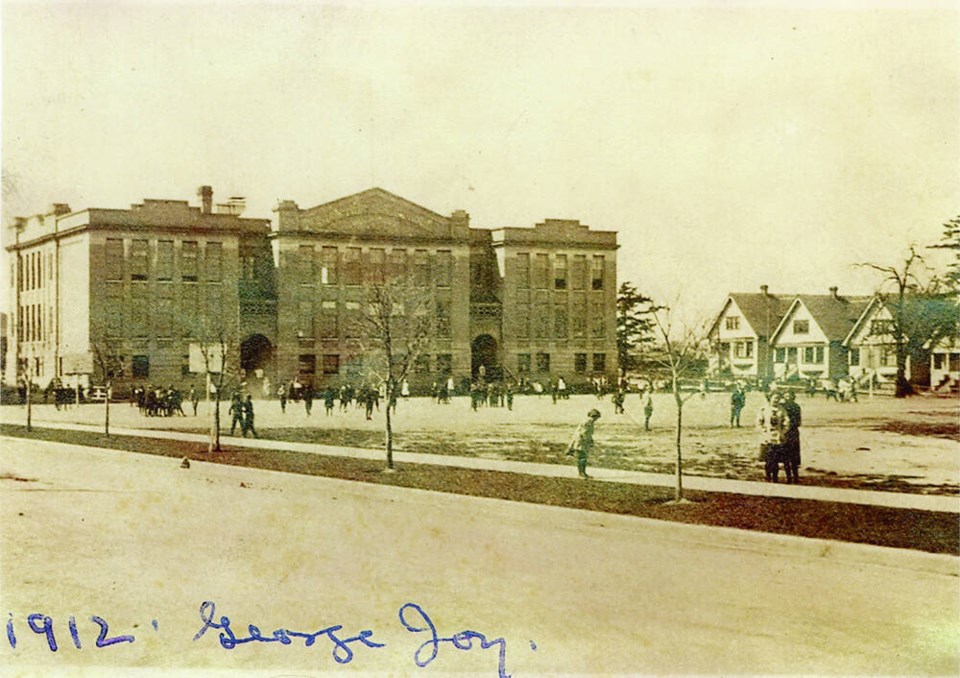A walk to mark the 100th anniversary of Victoria’s Chinese students’ school strike of 1922-23 — a protest against separate schools for Chinese-Canadian students — is being held Monday, starting from George Jay Elementary.
Chinese students boycotted classes for a year to protest efforts to expand segregation of Chinese students to the end of Grade 7.
Previously, Chinese students from grades 1 to 4 had been segregated under a policy implemented in 1908 by George Jay, chairman of Victoria’s school board from 1907 to 1934.
Jay would become the namesake of the 1118 Princess Ave. school, although the Greater Victoria School Board has voted to move ahead with a name change. Discussions are now going on that include the Esquimalt and Songhees First Nations.
The new rule came into effect on Sept. 5, 1922.
That day, principals removed Chinese students from class and led them to the Chinese Public School on Kings Road. As the students got close to the building, they dispersed, refusing to attend. The school strike would last for a year.
The strike was supported by the Chinese Canadian Club, the Chinese Commerce Association and the Chinese Consolidated Benevolent Association
Jay also brought in a policy in 1908 requiring Chinese children to pass an English test to attend public schools. The rule did not apply to children of other nationalities.
The Chinese Consolidated Benevolent Association launched a legal challenge and the policy was adapted to allow Chinese-Canadian students born in Canada to enroll in school. Children born in China who did not pass the exam still had to seek an another mode of education.
Current board chairman Ryan Painter said that among a “long list of historic wrongs perpetuated against the Chinese community in Victoria,” the strike stands out as a “particularly dark incident” in the school district.
“The racist discrimination that led to this act is unacceptable and viewed with regret,” Painter said in a statement. “The Greater Victoria School Board apologizes for the actions of its previous trustees and former board chair, George Jay.”
He said trustees will work with the Chinese community to ensure that what happened in 1922 is not forgotten, and to celebrate the community’s “immense contributions” to the City of Victoria and southern Vancouver Island.
Alan Lowe, chairman of the Victoria Chinatown Museum Society, said that what started as a school boycott became a protest movement for equality that brought together the Chinese community locally, regionally and nationally.
“Those of us of Chinese descent who were born and raised in Victoria were able to attend public schools because of those who preceded us.”
Victoria Mayor Lisa Helps said she plans to take part in the walk at the invitation of council colleague Charlayne Thornton-Joe.
“I find it shocking that, even in 1922, this level of discrimination was present in our city,” she said.
“When you think about it, it’s not that long ago. To think that the school board in the summer of 1922 sat down and said: ‘It’s a good idea to exclude Chinese-Canadian children from public schools,’ it’s quite shocking to think about it in those terms.”
Helps said she will walk “in support and solidarity” with the Chinese-Canadian community in Victoria.
“I think it’s a really important event,” she said. “Anybody who is concerned about or cares about making sure that Victoria is a welcoming and inclusive community, it’s a great opportunity to come and participate.”
Thornton-Joe said that she is interested in all things to do with Chinese history and reconciliation.
“I think it’s important for us to know the history and make sure we don’t repeat the history,” she said. “Also when you look at the increase of anti-Asian sentiments since COVID, I think it’s another reason for us to recognize some of the hardships and the discrimination that the Chinese community have endured through the years, but they’ve persevered and there’s also many success stories.”
The walk will start at 10:30 a.m. at George Jay Elementary. Lowe said it will be a 20- to 30-minute walk to the approximate former location of the Chinese Public School at Kings Road and Wark Street, near the former Blanshard Elementary School.
A commemorative luncheon will be held at 12:15 p.m. at the Golden City Restaurant, 721 Fisgard St. For ticket information, contact Lowe at [email protected].
In ISLANDER: “The Chinese community stood up for what had to be done”

.png;w=120;h=80;mode=crop)